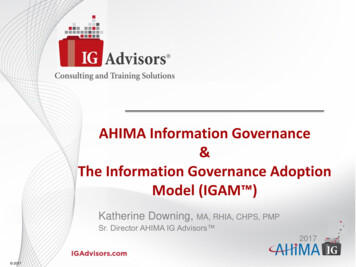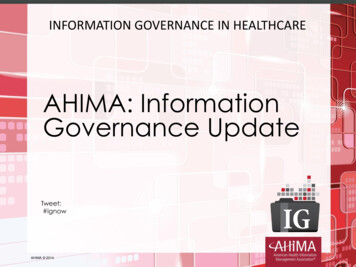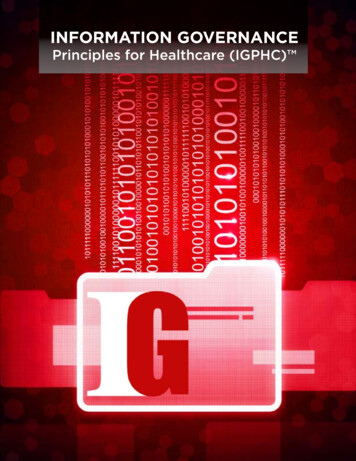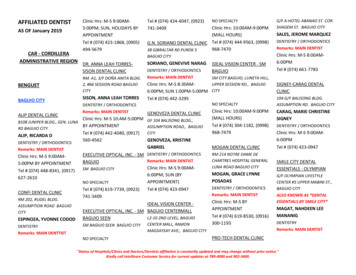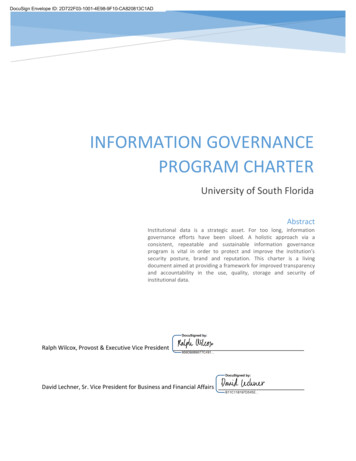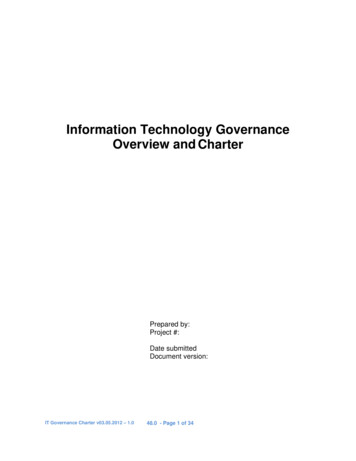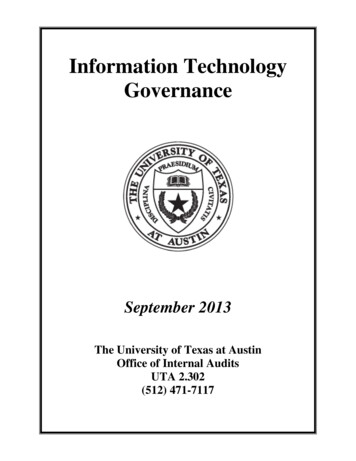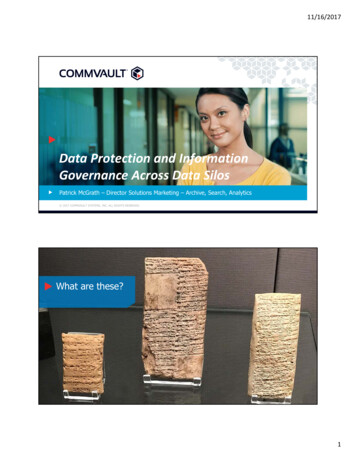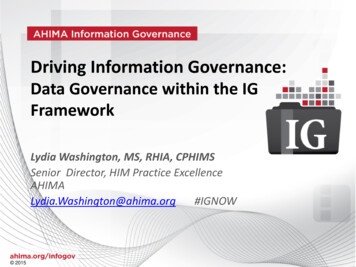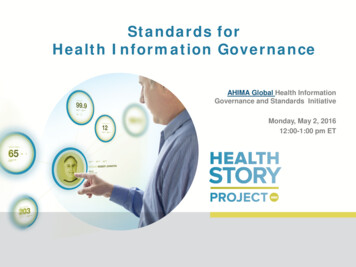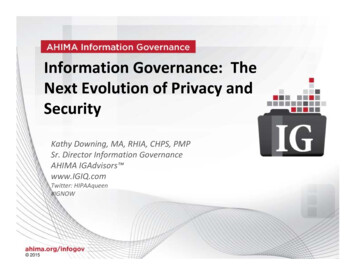
Transcription
Leading InformationGovernance for HealthcareDanika Brinda, PhD, RHIA, CHPS, HCSIPPContent Provided by theCSA Excellence Presentation Series 2016
AHIMA Strategic Initiatives Information GovernanceInformaticsPublic GoodInnovationLeadership 2016
AHIMA: Leading InformationGovernance for Healthcare Why is Information Governance (IG)important? Why is IG needed for Healthcare? What is IG? Review and understand thedirection of AHIMA’s IG Work 2016
Why IG?Disruptive TechnologyRate of adoption and volume of electronic systemsRate of growth, types and volume of devicesLack of agreed upon rules/standardsState of interoperability 2016
TRUST: The Reason for IG in HealthcareSafe Use of Health ITRight Patient – Right InformationQuality Care - Lower CostsReduced Information RiskReliable Performance MeasuresProof of the Value of Care PurchasedTrust in Exchange PartnersReliable Analytics – Decision SupportA Learning Health SystemAppropriate and Ethical Use of InformationA State of InteroperabilityResearch – Population Health 2016
AHIMA: Leading InformationGovernance for HealthcareOrganizations across multiple industriesrecognize the need to value and controltheir information, and nowhere does thismake more sense than in healthcare.Control requires governance. Governancerequires the adoption and ingraining ofprinciples, a framework, rules andmanaged processes. 2016
2016
AHIMA’s Definition ofInformation GovernanceAn organization-wideframework for managinginformation throughout itslifecycle and supporting theorganization’s strategy,operations, regulatory, legal,risk, and environmentalrequirements 2016
IG’s Dual Purpose:Stewardship forcompliance and riskmanagementEnhanced ability toleverage informationto achieveorganization’s goals 2016
An Information GovernanceFramework Addresses: Who is accountable for what How information strategy aligns with theorganization’s goals How information is valued forpreservation/retention/managingassociated costs Roles, policies Standards (data and information mgt) Metrics 2016
IG: Different than InformationManagement (IM) IG is Strategic Applies to all types of information, not just clinical Breaks down the silos that prevent consistency andstandardization of uses, policies and processesacross the departments and business units of theorganization and even outside of its walls 2016
IG for Healthcare IG is not JUST needed in hospitals .but in alltypes of delivery settings, and across thehealthcare ecosystem . Wherever information isexchanged, used, administered, analyzed,released, stored, archived or deleted/destroyed,it must be governed. IG is NOT an IT project it is not a project at all but an ingraining of principles, a framework, rulesand processes for managing and controllinginformation across the organization. 2016
Information GovernanceHealthcare There must be acceptance that information is amission-critical asset to be controlled throughout itslifecycle. Data and information regardless of medium must beincluded All information must be governed .IG in healthcarecannot be limited to health information Data andinformation supporting the business of the entireorganization must be governed. 2016
AHIMA: Leading InformationGovernance for Healthcare Establishing an expert advisory panel Conducting surveys on IG inhealthcare Publishing white papers on IG Develop principles for IG in healthcare Developing a maturity model and selfassessment tools Developing, refining and providingresources to operationalize IG Providing references, webinars andforums to raise awareness of IG 2016
AHIMA - Leading theWay in Healthcare IGIG Survey-State of IGIG Principlesfor HealthCare20142013Strategic Initiative:Driving the Adoptionof IG in Healthcare2017Refine IGHealthRateGrow ToolkitPilot Learnings20162015Refine IGPulseRateIG Pilots, Grow ToolkitShare LearningsLaunch IGHealthRateIG Adoption ModelIG Survey-ReadinessIG Pilots LaunchAHIMA IG ToolkitIG Solutions Launch:IGPulseRate, IG AdvisorsIGIQ 2016
AHIMA: Leading Information Governance forHealthcarePrinciples—IGPHC Accountability TransparencyADAPTED FORHEALTHCARE Integrity Protection Compliance Availability Retention DispositionAttribution—ARMAInternational. GARParma.org 2016
Ministry Door County Medical Center25-Bed Critical Access Hospital in WIWorking on Establishing a Committee to Encompass IGCurrent committee addressing:– Governance of clinical and operational information in order toimprove quality of care and patient safety– Improve population health– Increase operational efficiency and effectiveness– Reduce costs– Reduce nization-makingmighty-strides-with-ig/ 2016
Though we may be small, we are makingmighty strides with IG. Informationgovernance is a team effort. It’s important tohave support for the cause from seniorleadership, as well as dedicated physicians,IT and HIM professionals, and clinicians tolead the way. No matter what the size of theorganization, the information assets areproportionately valuable.– Betty Rockendorf, Director of Health InformationManagement and Privacy Officer 2016
AHIMA IG Adoption Model TM Five-level model Defines characteristics of governance practices atadvancing levels of maturity Rooted in IG best practices, standards andrequirements Introduces constructs of IG organizational“competencies” that are enumerated byperformance-driven “markers” 2016
AHIMA IG Adoption Model TMBroad use of the Adoption Model will enable: A recognized scoring mechanism for IG adoption levels Peer group benchmarking An indication of trustworthiness of an organization’sinformation An indication of partnerships desirability foraccountable care, preferred provider networks, andinformation exchange participation 2016
AHIMA’s IG Adoption ModelPrinciples: Accountability Transparency Integrity Protection Compliance Availability Retention DispositionIG OrganizationalCompetencies: Strategic AlignmentOrganizational StructureAwareness & AdherenceIG Performance ManagementRegulatory & Legal ResponseStandard Operating PoliciesData GovernanceTrustworthinessSecurity & PrivacyLifecycle Management 2016
IG Adoption Model Within each of the 10 competencies are specificperformance markers Each performance marker is described at eachlevel Organizations can then assess and score bymarker, by competency and overall 2016
IG Adoption Model Subscription-based solution. Detailed self-scoring of IG maturity. Uses a 5-Level, 5-point scoring system basedon maturity markers across 10 IGOrganizational Competencies (IGOC). Yields maturity scores in the aggregate andby competency. Multiple views of maturity levels based onorganizational needs. Industry peer group benchmarking fromgranular to aggregate levels. Integrates guidance and coaching based onlevels attained. Enables the organization to establish a pathfor achieving maturity goals. 2016
2016
AHIMA: Leading InformationGovernance for HealthcareThe time has come forhealthcare to adoptgovernance ofinformation.Trust in health informationdepends on it. 2016
Leading Information Governance forHealthcareThe Time is NOW! Sharpen your leadershipskills Build relationships Communicate/collaboratewith others about IG benefits Learn all you can about IGAHIMA’s IG Pagehttp://www.ahima.org/topics/infogovernance orIGIQ.com#IGNow 2016
Online Toolkitwww.arma.orgInitial Content:ChartersOrg ChartsSample PlansRole DefinitionsPractice GuidelinesSample ProceduresArticlesCase StudiesTools for:ROI, Classification,Valuation,Defining Data & Info Uses 2016
AHIMA’S IG INITIATIVES –WHAT’S NEXT? Webinars Boot camps LeadershipForums Summits Journal articlesand practicebriefs 2016
Upcoming Webinars 2016
Upcoming In-Person Meetings 2016
-of-consumer-engagement-in-ig-advocacy/ 2016
-id-a-perfect-match/ 2016
Questions 2016
AHIMA: Leading Information Governance for Healthcare Organizations across multiple industries recognize the need to value and control their information, and nowhere does this make more sense than in healthcare. Control requires governance. Go
